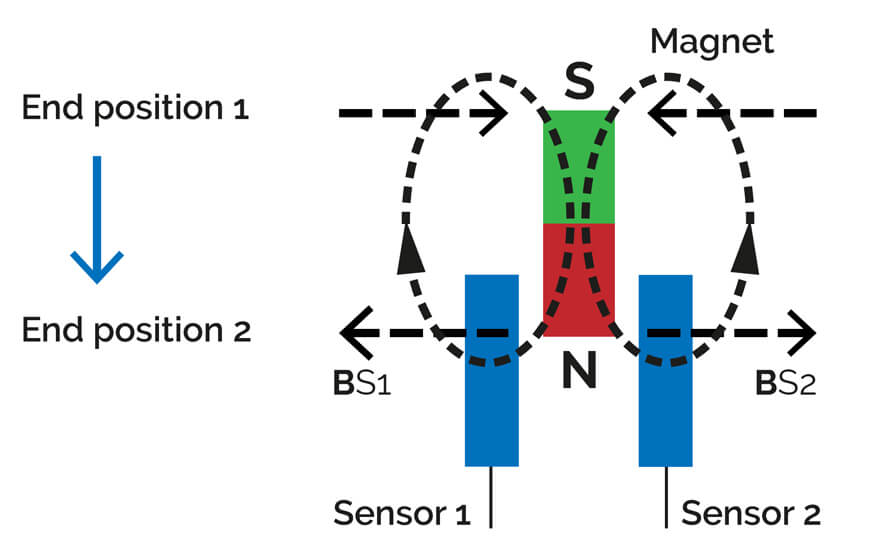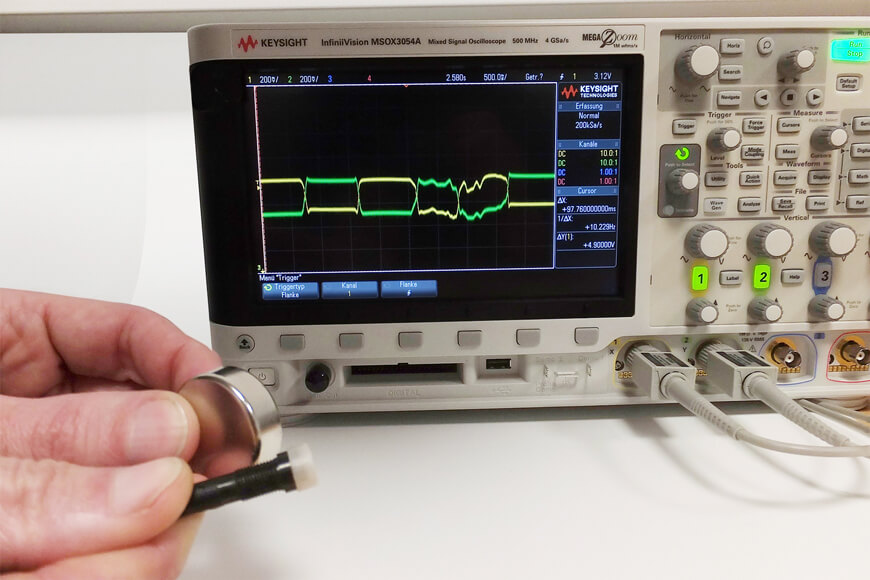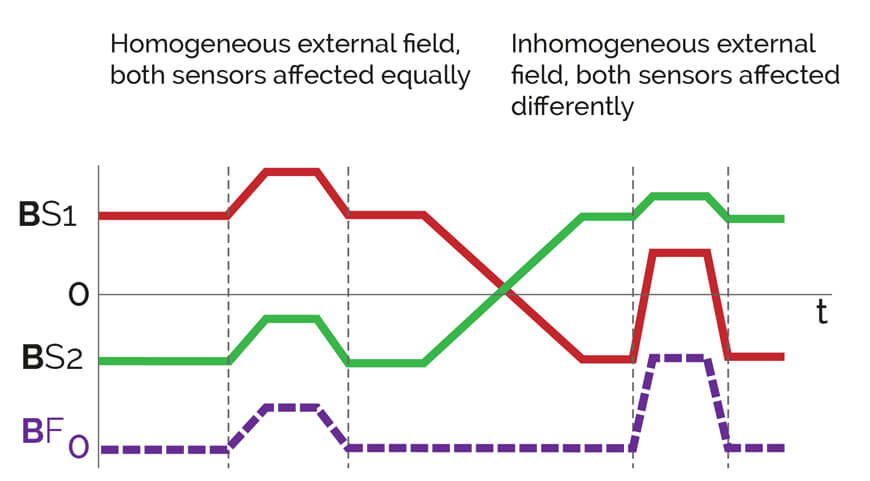Novel design principle for Hall switches
Thanks to the new switching concept developed by Griessbach, extremely low-wear Hall sensor circuits can now be integrated into virtually any common switch and pushbutton formats to enable reliable operation without interference through external fields. Due to a new sensor and magnet arrangement, the switching signal is effectively protected from EMI even without additional shielding or multi-dimensional sensors. The following article outlines the design and function of the new switching principle.
We have filed a patent for our newly developed Hall switching concept that can be adapted to a wide variety of switching components used for machine operation. The switching principle is immune against external magnetic fields and can be adapted to the specific requirements of individual switch assemblies. This allows keyboard and switch manufacturers to use Hall technology more widely and also to realize very small footprints.

Griessbach’s innovative switching principle immunizes Hall circuits against magnetic interference fields
Construction and functioning of the new principle of operation
Wear-free switching principle
Based on solid-state switching, Hall sensors are subject to minimal mechanical wear and tear, unlike electromechanical switches. They are also resistant to vibration, temperature fluctuations, dirt, and humidity. Conventional Hall switches have a weakness, however: they are susceptible to interference from external magnetic fields. We have developed a new switching concept that successfully protects switching signals from such distortion sources and prevents faulty switching.
Neutralizing interference fields
Depending on the mounting position, conventional Hall switches can be affected by external magnetic fields. If the surrounding enclosure does not provide sufficient shielding, additional constructive measures are needed to rule out the risk of faulty switching. However, additional protective shielding or integrated 3D or external field sensor solutions with the associated software make the use of Hall sensors relatively complex and costly.
The new Griessbach switching principle works without any such additional protective measures. It can therefore also be employed in small short-travel switches with a 1-mm actuating path and in joystick pushbuttons with a diameter of 8 mm or more. It is suitable for all types of actuators: pushbuttons, rotary switches, selection switches, slide switches, and rocker switches common in automotive applications. In order to achieve high performance levels, all switch variants can implement automatic diagnosis and/or a two-channel design. Also, all enable high switching cycle numbers.
Differentiated signal acquisition
Our novel approach is to base the solution on a special design principle linking the switching state and signal evaluation to the magnetic field difference. Opposite magnetic fields are created in minimal space by means of magnets installed in the plunger. Their respective polarity is detected by opposite Hall sensors with saturation limits ranging from 100 mT to 300 mT. Due to the magnetic field change when the pushbutton or switch is operated, the output voltage generated by the sensors is minimized or inverted – depending on the specific configuration of the switching principle. Any field changes are analyzed by a comparator or microcontroller, and switching signals are only triggered, if the differential signal changes its polarity, or if it exceeds or falls below predefined switching points (hysteresis). This means that the switching state can only be changed by operating the switch. Notably, it cannot be changed by homogeneous external interference, because the positive or negative differential signal is balanced when the limit position is reached.
BS1: Magnetic flux density at sensor 1
BS2: Magnetic flux density at sensor 2
EMI-free Hall circuit through detection and evaluation of opposite charges from other field components
The differential signal stays intact: measured interferences caused by inhomogeneous external magnetic fields before and after actuation
Protected against inhomogeneous interference
This switching concept can furthermore also almost completely prevent faulty switching caused by inhomogeneous external interference fields. In test series with a wide range of prototypes, even strong neodymium magnets with flux densities of 0.6 T positioned directly on the switch did not influence the switching state. Field changes indicated by an oscilloscope only resulted in minor modification of the differential signal. Thus, the signal is protected from a change of the switching state caused by polarity reversal, even in these cases.
Variable functional design
The Hall switching concept modified by us has a wide range of possible applications. We can adapt the design to individual switching tasks and switch styles, rearranging the sensors and magnets, for example, to realize particularly low-height switches or redundant evaluation of the sensor circuit. For maximum protection, the differential signal can be doubled. For this purpose, the orientation of the field is rotated by 90°. Instead of the magnetic axis running in parallel to the sensors (illustration no. 2), the axes then run vertically to the detection surfaces. This design achieves a maximum differential signal, whereby the switch is comprehensively protected against external field interference in both end positions. This increased interference protection can be achieved by integrating three magnets or one multipole magnet. Slimmed-down variants with one or two magnets are suitable for all switching functions that do not require such a high protection factor at an end position.
Conclusion
The improved Hall sensor technology and signal evaluation developed by us is a very reliable, low-wear alternative to electromechanical switches. It allows for cost-optimized integration in minimal space and is available now to make many applications that still use electromechanical switches more robust. The newly developed switching concept ensures noise-immune operation regardless of the installation position. Therefore, the switches can also be redundantly configured and flexibly installed.



